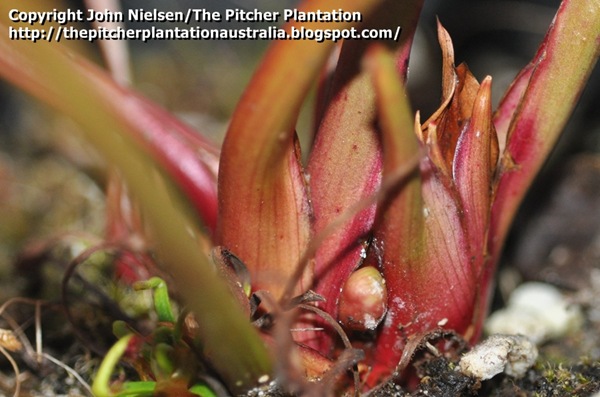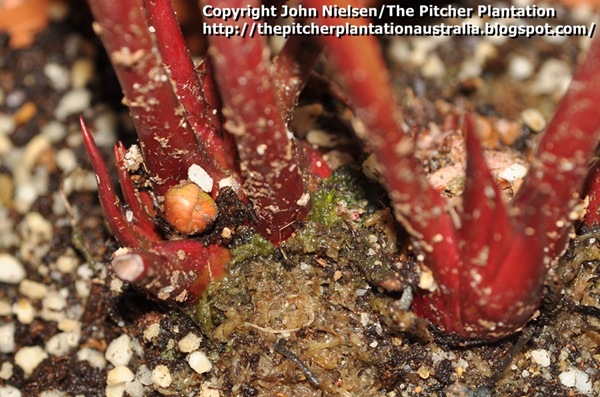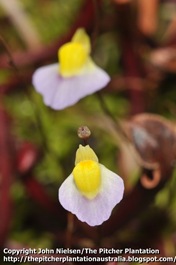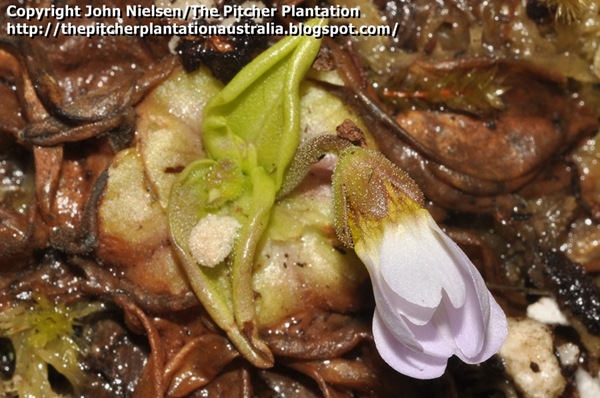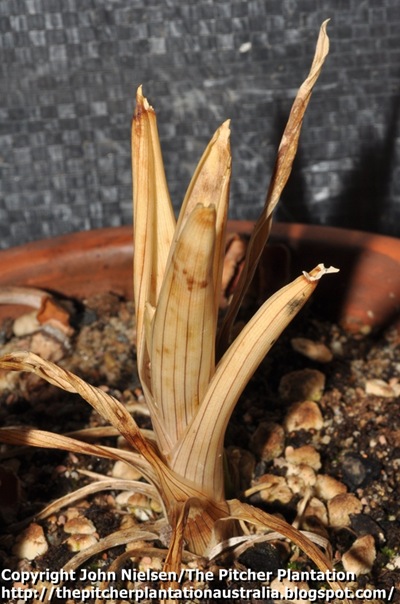As the days start to get longer, the dormant plants in the greenhouse start to show signs of breaking dormancy. One of the first to break dormancy, an all red S. alata I call “Biddlecombe Red”, put on a good start with flower buds and a couple of new pitchers. Sarracenia alata is a problem for me here because they break dormancy way too early and burn badly. This plant was no exception and its new pitchers were burned during the two coldest days this winter (–8*C and –7*C). The flower bud is so far intact and looks to be the fastest growing of the handful of flower buds coming up.
Other budding plants include one of the few hybrids I grow, a S. flava look-a-like that is S. ((flava x purpurea) x flava) x (alata x flava). Its pitchers look like dwarf S. flava var. rubricorpora. I’ve had the plant since January this year and note that it behaves like S. flava in having spring-dominated growth, although it lasts a lot longer into the season than its pure S. flava doppleganger.
Another is a S. flava var. ornata that may or may not be a hybrid. It looks a lot like a plant my friends in Victoria grow that seems to have S. oreophila in it, only my plant has a strong red flush that nicely compliments its very dense veining. I didn’t give its flower a second glance last year, so I’ll pay double attention to it this year. 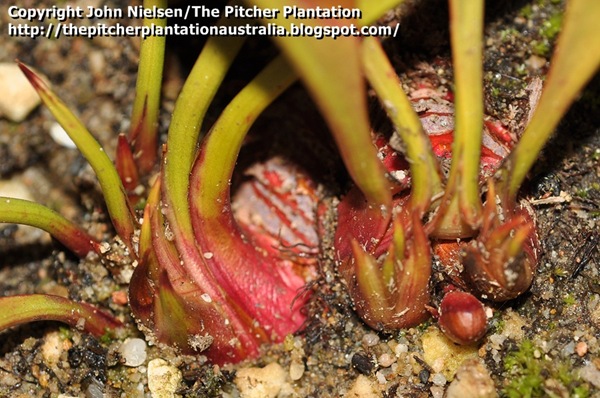
I’m not counting most of David Martin’s plants this year, as most had already developed flower buds before I received them in June. David’s conditions in Queensland were so mild that some plants stopped growing for perhaps a week around shortest day, before sending up new pitchers and flowers. Here is a paused flower bud on a lovely S. flava var. cuprea David called “F1”. It was his first ever Sarracenia, grown from seed in 1980. The divisions I have of this clone are some 30 years old!
Despite the cold, some plants simply have not gone dormant. This unidentified Utricularia has been flowering madly all winter. I’m hoping it self pollinates and invades a few more pots – it would be nice to have a carpet of these flowers next winter.
In the same pot as these plants are seedlings of S. flava var. atropurpurea that Ron Abernethy gave me last year (thanks Ron!). I’ll dose them up on some slow release fertiliser as soon as they break dormancy. I use the slow release Osmocote for native plants, as it has low levels of phosphates that encourage slime moulds and algal growth on peat substrates. I have even used this fertiliser at full strength (unintentionally) on Sarracenia growing in live Sphagnum moss with no ill effects.
On the topic of Lentibularaceae, here is my one and only Pinguicula primuliflora in flower. It was a lot bigger than this in Autumn; this is what happens when they are grown under very cold conditions. I think the reason it has survived is because of some new water trays I built for the Sarracenia. In my experience, cold-tender plants do well if kept close to lots of water (which acts as thermal mass and stops frost forming) or if they are kept quite dry. The amount of water in the tray my P. primuliflora grows in takes 21 x 200 mm/8” pots and is 10 cm (4”) deep when filled with water. It takes a lot of cold to make that amount of water freeze, so the plant has been protected.
In contrast, my Brochinia reducta (a carnivorous bromeliad) died because its soil got wet, but the thermal mass of the water tray it was in did not stop it from freezing and dying. If I had kept it dry (like I had done previously, mostly from neglect), it would probably still be alive. I have successfully overwintered a Nepenthes x gothica through minimums of –6*C because I kept it in a very open, well drained mix that stayed rather dry. In the end, it looked a bit the worse for wear, but it was still very much alive and recovered fully that spring and summer. So to close, here is what happens to Brochinia reducta if they are allowed to freeze in a –8*C frost:

